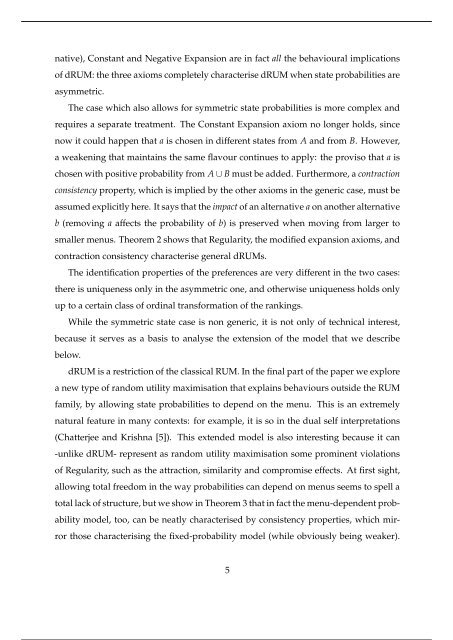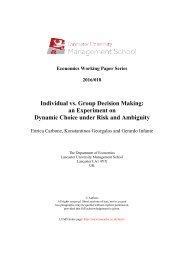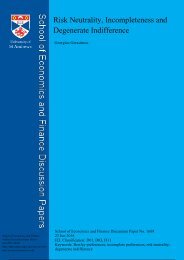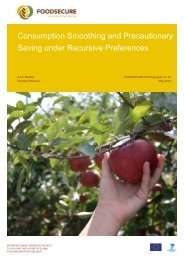Dual Random Utility Maximisation
n?u=RePEc:san:wpecon:1605&r=upt
n?u=RePEc:san:wpecon:1605&r=upt
Create successful ePaper yourself
Turn your PDF publications into a flip-book with our unique Google optimized e-Paper software.
native), Constant and Negative Expansion are in fact all the behavioural implications<br />
of dRUM: the three axioms completely characterise dRUM when state probabilities are<br />
asymmetric.<br />
The case which also allows for symmetric state probabilities is more complex and<br />
requires a separate treatment. The Constant Expansion axiom no longer holds, since<br />
now it could happen that a is chosen in different states from A and from B. However,<br />
a weakening that maintains the same flavour continues to apply: the proviso that a is<br />
chosen with positive probability from A ∪ B must be added. Furthermore, a contraction<br />
consistency property, which is implied by the other axioms in the generic case, must be<br />
assumed explicitly here. It says that the impact of an alternative a on another alternative<br />
b (removing a affects the probability of b) is preserved when moving from larger to<br />
smaller menus. Theorem 2 shows that Regularity, the modified expansion axioms, and<br />
contraction consistency characterise general dRUMs.<br />
The identification properties of the preferences are very different in the two cases:<br />
there is uniqueness only in the asymmetric one, and otherwise uniqueness holds only<br />
up to a certain class of ordinal transformation of the rankings.<br />
While the symmetric state case is non generic, it is not only of technical interest,<br />
because it serves as a basis to analyse the extension of the model that we describe<br />
below.<br />
dRUM is a restriction of the classical RUM. In the final part of the paper we explore<br />
a new type of random utility maximisation that explains behaviours outside the RUM<br />
family, by allowing state probabilities to depend on the menu. This is an extremely<br />
natural feature in many contexts: for example, it is so in the dual self interpretations<br />
(Chatterjee and Krishna [5]). This extended model is also interesting because it can<br />
-unlike dRUM- represent as random utility maximisation some prominent violations<br />
of Regularity, such as the attraction, similarity and compromise effects. At first sight,<br />
allowing total freedom in the way probabilities can depend on menus seems to spell a<br />
total lack of structure, but we show in Theorem 3 that in fact the menu-dependent probability<br />
model, too, can be neatly characterised by consistency properties, which mirror<br />
those characterising the fixed-probability model (while obviously being weaker).<br />
5






